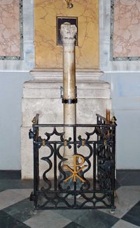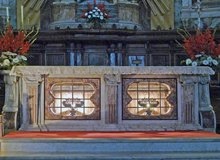


St Firmina
High altar, Duomo, Civitavecchia
Two entries in the Roman Martyrology are relevant:
-
✴One, under 24th November, reads: “At Amelia in Umbria, during the persecution of Diocletian, St Firmina, virgin and martyr. After being subjected to various torments, to hanging, and to burning with flaming torches, she yielded up her spirit”.
-
✴A second, under 1st December, reads: “At Amelia in Umbria, St Olympias, ex-consul, who was converted to the faith by blessed Firmina, was tortured on the rack, and under Diocletian achieved martyrdom”.
According to the legend of St Firmina (BHL 3001), she was a Roman virgin, daughter of the Urban Prefect Calpurnius. When she was threatened in Rome by the persecutions of 303 AD, she fled to her family's villa near Amelia. During her flight, she saved Civitavecchia from inundation by the sea: this event that is still celebrated there on 28th April, when her statue (illustrated above) is taken from the Duomo to the harbour, and then by boat to the ancient lighthouse.
St Olympias, the consular prefect of Amelia, continued her persecution, but she managed to convert him to Christianity. He was subsequently martyred and St Firmina buried him outside Amelia.

A copy of BHL 3001d is preserved under 29th November in the Leggendari del Duomo.
The relics of the SS Firmina and Olympias were preserved at Castellum Luchianum. This was probably near modern Lugnano in Teverino, some 10km west of Amelia: a church there dedicated to SS Firmina, which was documented in the Middle Ages, was identified in 1914 and excavated in 1931. (Architectural fragments (ca. 1200) that probably came from these excavations are now in the courtyard of Palazzo Comunale).
According to a 14th century document, Bishop Pasquale (documented in 868-79) began the construction of a church that stood on the site of the present Duomo. He translated the relics of SS Firmina and Olympias (together with those of St Himerius) to this new church in the reign of Pope Adrian II (867-72).

The relics of SS Firmina and Olympias, which had been moved from the old Duomo as the Emperor Frederick II approached, are now preserved under the high altar (1648).
Return to Saints of Amelia.

